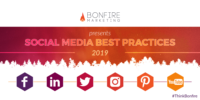We believe in the power of content marketing. It ensures the longevity of brands and promotes both awareness and consumer conversions. Content marketing is about putting the customer first and delivering worthwhile, helpful content to strengthen the business-customer relationship.
Often, the sticking point with content marketing is not adopting the ideology, but the execution of it. You can create original content every day, but without the strategy to deliver it to your audience, it won’t get the reads or shares it deserves. We’ve rounded up a few of our methods (fortified by industry research) for developing a content calendar of your own.

Why use content calendars?
A content or editorial calendar is the foundation for executing your brand’s content marketing strategy. Calendars should be easily accessible by all members of your team to keep everyone up to date on current campaigns. This visual document keeps track of all of your brand’s content, from social media posts to blogs, email newsletters, and more. By planning ahead on a quarterly basis, you’ll benefit from fewer missed deadlines and last-minute content changes. This versatile tool will keep your brand on budget and on schedule.
In 2016, 88 percent of B2B companies and 76 percent of B2C companies used content marketing. That’s indicative of successful results. Additionally, content marketing generates six times more conversions than traditional marketing. With so many businesses and brands benefiting from content marketing, effective tools are more valuable than ever. Don’t get bogged down in the swamp of bad content.
Audience analysis
Before creating your content calendar, there’s research to be done! Start by looking at your audience. Creating detailed customer personas is the best way to understand your audience, and ensure you’re constantly tailoring content for the right demographic.
Persona development
How do you create a persona? Consider four key qualities of your target customers: geographic, demographic, psychographic, and behavioral. Using tools like Facebook Insights and Google Analytics, analyze who is visiting your site and engaging on social channels based on each attribute.
Many brands are focused on local markets, so identifying where your consumer lives is one key differentiator. The more specifics you can garner from your existing audience, the more targeted your content can be to more people like them. Identify the general demographics of your customers. How old are they? Do the have a family? What are their interests and professions? From preferred social channels to favorite TV shows, these insights come together to define who your customer is.
Content analysis
Once you know your target demographics, use tools like Twitter Analytics, Facebook Insights, and SimplyMeasured to see how they engage with your content.
Historical data
Identify which campaigns worked well for your brand in the past, and replicate variations of them in the future. Previous campaign information can also inform posting frequency and times. Take a look at the top engagement times for each platform, but understand these times vary by industry. Combine industry knowledge with your historical data when honing in on where, when, and how frequently to publish your content.
Audience data
Keep your audience’s age and preferred platforms in mind when planning content. Look at the performance of every content outlet you publish on. Where are your customers engaging most? Where can you make the smartest investment for your time and budget? Great content comes from being actively aware of what your customer wants.
Build your calendar
With the research done and your content plan created, it’s time to build your calendar! Use a mix of social media, blog posts, infographics, videos, and email campaigns to communicate with your target audience. Continue monitoring engagement with analytics to adjust strategy accordingly.
Social media
Customer demographics play a huge role in determining which channels your audience will engage with most. Produce posts for each one keeping in mind the purpose of content marketing: adding value to your brand in the eyes of your audience.
Share a balanced mix of third-party articles (with proper mentions for attribution and influencer outreach), links to your latest blogs, infographics, videos, and graphics to build brand awareness on social media. Remember to constantly test and try new content types. It’ll keep your pages fresh and your audience engaged.
Infographics
An infographic is 30 times more likely to be read than a purely textual article. They’re your chance to go in-depth on a topic, create original, researched content, and provide an effective visual medium for communicating your ideas.
Blogs
In the world of blogs, long-form ranks high. Blogs of over 1,000 words receive 2 times more mobile engagement than short-form content and just as many visitors. Those are impressive stats! Consider starting with a mix of evergreen blogs and promoted products. Employ guest writers or influencers to add some diversity to your blog topics, and remember to optimize for SEO. Get started with our guide to blog writing and find some inspiration.
Video marketing
Video marketing is here to stay! Consider repurposing some of your blog content into short videos. With the autoplay function on Facebook, you’re guaranteed to get good reach. Live video is also on the rise, so consider showcasing product releases and your company culture through live-streaming videos.
Email marketing
You’re six times more likely to receive click-throughs in email than on Twitter. Those numbers are just one indicator of the opportunities available to your brand through email marketing. Effective campaigns use a mixture of branded promotions, evergreen content, and company updates. When done right, you can target and segment your customers and communicate with them on a personal level. Use your blog as inspiration, and consider if any of its content can be repurposed as an email marketing campaign.
Scheduling and posting
Scheduling and posting are the final steps in your content calendar. Following through on your strategy is key to seeing results. Use scheduling applications like Spredfast, HootSuite, CoSchedule, or TweetDeck to ensure everything is posted in a timely manner. These programs can cut down on the amount of time you spend posting your material while giving you transparency across your social platforms.
Add value to your customers’ lives, ensure your brand’s longevity, and formalize your editorial process with the help of a content calendar. View our infographic on Visually, then use it as a guide to start researching and building your own content calendar to solidify your editorial process today. You should also download our 2017 Social Media Best Practices to use as a reference when creating your content. Now go get started!
More Content
Fundamentals of Effective Marketing Reporting
Effective marketing isn’t based on hunches. That shouldn’t come as a shock to anyone, since we hear all the time about the importance of making data-informed decisions, regardless of what
5 Best Practices for a Hardware Product Launch
If you work in technology, you’re familiar with the hype around a new product launch. Hardware product launches these days are made for the digital world, and that means throwing
The Ultimate Social Media Best Practices 2019 [Infographic]
Jump ahead to best practices for: Facebook Posts Facebook Paid Posts LinkedIn Posts LinkedIn Sponsored Content Pinterest Pins Pinterest Promoted Pins YouTube Videos When I began my work with Bonfire,




Leave A Comment